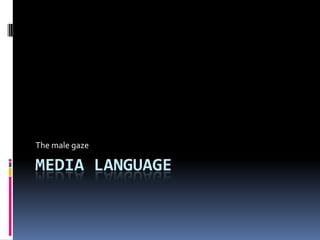
Media language the male gaze
- 1. The male gaze MEDIA LANGUAGE
- 2. The "male gaze" in feminist theory In Mulvey's 1975 essay, "Visual Pleasure and Narrative Cinema", Laura Mulvey introduced the feminist concept of "male gaze" as a feature of gender power asymmetry in film. Mulvey stated that women were objectified in film because heterosexual men were in control of the camera. Hollywood films played to the models of voyeurism and scopophilia.[The concept has subsequently been influential in feminist film theory and media studies. The male gaze[occurs when the camera puts the audience into the perspective of a heterosexual man. It may linger over the curves of a woman's body, for instance.[ The woman is usually displayed on two different levels: as an erotic object for both the characters within the film, as well as the spectator who is watching the film. The man emerges as the dominant power within the created film fantasy. The woman is passive to the active gaze from the man. This adds an element of 'patriarchal' order and it is often seen in "illusionistic narrative film". []Mulvey argues that, in mainstream cinema, the male gaze typically takes precedence over the female gaze, reflecting an underlying power asymmetry. Mulvey's essay also states that the female gaze is the same as the male gaze. This means that women look at themselves through the eyes of men.[ The male gaze may be seen by a feminist either as a manifestation of unequal power between gazer and gazed, or as a conscious or subconscious attempt to develop that inequality. From this perspective, a woman who welcomes an objectifying gaze may be simply conforming to norms established to benefit men, thereby reinforcing the power of the gaze to reduce a recipient to an object. Welcoming such objectification may be viewed as akin to exhibitionism.